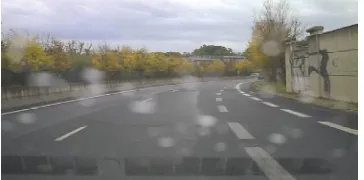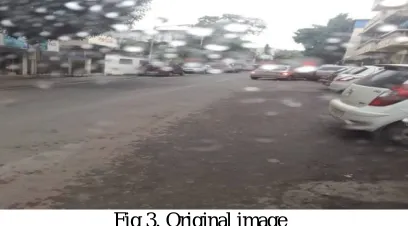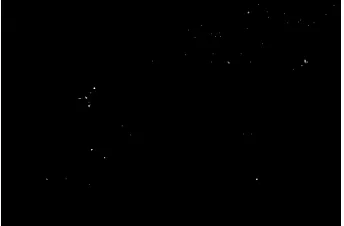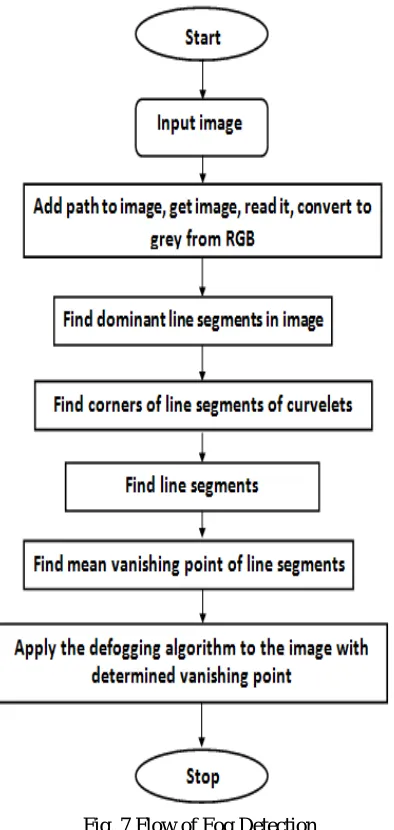ISSN(Online): 2320-9801
ISSN (Print): 2320-9798
I
nternational
J
ournal of
I
nnovative
R
esearch in
C
omputer
and
C
ommunication
E
ngineering
(An ISO 3297: 2007 Certified Organization)
Vol. 4, Issue 9, September 2016
Unfocused Raindrop Detection Using
Segmentation and Fog Removal Using
Defogging Algorithm
Timalapur Jahnavi Nagaraj1, Prof Vijay.B.Baru2
M. E, Dept. of E&TC, Sinhagad College of Engineering, Pune, India
Professor, Dept of E&TC, Sinhagad College of Engineering, Pune, India
ABSTRACT: In the world of increase demand for vehicle the driver is upheld by camera based advanced driver assistance system (ADAS) which are a key part for further enhancements in wellbeing and driving solace. Imaging sensors in ADAS are performing well under great climate conditions, their proficiency reduce in unfavorable condition like rain, haze, fog. To handle such optical dangers and to improve data nature of cameras the method aim to detect raindrop and fog from set of images.The project exhibit a novel approach that goes for recognizing raindrops on an auto windshield and fog in surrounding environment utilizing just pictures from an as a part of vehicle camera. In view of the photometric properties of raindrops, the calculation depends on picture preparing techniques to highlight raindrops. Its outcomes can be further utilized for picture rebuilding and vision upgrade and consequently it is a significant apparatus for ADAS.
KEYWORDS: Traffic safety, visibility, average grey value, DWT, Advance driver assistance system, unfocused raindrop, Defogging.
I. INTRODUCTION
To detect and characterize degraded visibility conditions, in particular due to the rain and fog , aims both at generating new driving assistances (switching on wiper and adapting their speed, alerting the driver if his behavior is inappropriate to visibility conditions) and to characterizing the operating domain of any driving assistance system relying on an optical sensor. Using extracted information, it is possible to adapt sensor functioning, to improve signal quality and to dynamically adjust system settings. Current onboard rain and fog detection systems are based on dedicated sensors. It is a combination of infrared emitter and receptor that uses the windshield glass as wave guide. A water drop and fog particles located on the sensor is deflecting a part of the infrared light allowing the detection. The reliability of such sensors is not questioned however they present some drawbacks. First, the water detection is localized on a small part of the windshield. Secondly, they do not provide quantified information on the water density on the windshield. Finally, those sensors may occupy a large place on the center of the windshield and decrease the driver visual comfort. To find an answer to those difficulties, we propose a new approach for rain and fog detection relying on a video camera. Assistance Systems (ADAS) based on video camera tends to be generalized in today’sautomotive. However, if most of these systems perform nicely in good weather conditions, they perform very poorly under adverse weather particularly under rain
ISSN(Online): 2320-9801
ISSN (Print): 2320-9798
I
nternational
J
ournal of
I
nnovative
R
esearch in
C
omputer
and
C
ommunication
E
ngineering
(An ISO 3297: 2007 Certified Organization)
Vol. 4, Issue 9, September 2016
Fig.2 Foggy image
Based on the photometric properties of raindrops, the algorithm relies on image processing techniques to highlight raindrops. Its results can be further used for image restoration and vision enhancementand hence it is a valuable tool for ADAS. Adverse weather conditions directly impact the driversafety, by both reducing the visibility distance and increasing the stopping distance.. Among expected in on board sensors, camera is one of the most promising because it is not expensive and may be shared by other applications for instance, obstacle detection or lane departure warning.An increasing number of vehicles are equipped with onboard cameras. As perception sensors, they scan the surroundingfield and supply data to the Camera based ADAS support the driver with timely risk identification to prevent accidents, e.g. by realizing an adaptive cruise control (ACC), traffic sign recognition, blind spot detection or even performing an emergency brake. While imaging sensors are performing well in good weather conditions, their efficiency suffers under adverse environmental influences such as heavy rain, fog, snow, glare of the sun, sandstorm and occlusion caused by dirt or other objects covering the windscreen such as ice.
As a consequence, a vision based ADAS may produce information of poor quality and the environmental model also becomes faulty. Driving a car in reduced visibility conditions can easily lead to severe accidents. Fog has huge impact on the visual range. A system which is able to alert the driver about this risk and automatically controls head- and tail-lights or reduces the speed of the vehicle might save lives. Furthermore, future vehicles may drive autonomously without driver interaction in environments with reduced complexity such as highways without cross-roads. These vehicles will make use of on board cameras and need to trust their sensor inputs or, in doubt; hand over the vehicle control to the driver. To address this security issue, an increasing number of research groups are focusing on self-diagnosis mechanisms for camera based advanced driver assistance systems. The project helps us to to perform different image processing operation on the distorted images to get a clear image. In this project there are two parameters, raindrop and fog on which the image processing algorithm is applied. Two methods that aim to detect unfocused raindrops and fog on a car windshield using only images from an in-vehicle camera are used here. Based on the photometric properties of raindrops and fog, the algorithms rely on image processing techniques to highlight them. The results will be used to improve ADAS behavior under rainy and fog conditions. The methods are based on the photometric properties of the raindrops and fog: brightness and blur.
Optical Threats
The most common threats leading to a degraded camera sight can be separated in following general classes with similar symptoms but different causes:
1) Block of view/scenedue to lens occlusion or blockage, 2) View blurred due to lens soiling or dirt optical faults caused by altering or damage
3) View range reduced due to adverse weather conditions such as fog, heavy rain, snowfall etc.
II. OBJECTIVE AND SCOPE
The main objectives of the project are:
1. Collect images from cameras associated with ADAS.
2. To find out the most powerful edges (dominant) by using Gaussian filtering,sobel edge detection, Harris corner
detector, curvelet mapping.
ISSN(Online): 2320-9801
ISSN (Print): 2320-9798
I
nternational
J
ournal of
I
nnovative
R
esearch in
C
omputer
and
C
ommunication
E
ngineering
(An ISO 3297: 2007 Certified Organization)
Vol. 4, Issue 9, September 2016
property of the raindrop and fog (brightness and blur).
4. To remove the fog from the image containing fog,
5. To perform segmentation on image to detect the raindropwhich will help to improve advance driver assistance
systems (ADAS) behavior
6. To detect and characterize degraded visibility conditions, in particular due to the rain and fog.
7. To perform defogging on foggy images using different image processing tools to remove the fog.
8. To characterizing the operating domain of any driving assistance system relying on an optical sensor. Using
extracted information, it is possible to adapt sensor functioning, to improve signal quality and to dynamically adjust system settings.
III. RELATED WORK
Garg and Nayar [11]–[13] proposed an accurate photometric model for stationary spherical raindrops and the detection of rain streaks based on the drops’ motion. However, even if this research is fundamentally interesting, the static observer and the long temporal integration (30 frames) make the approach unsuitable for moving camera scenarios.
Yamashita et al. [14] and Tanak et al. [15] proposed several approaches for detecting and removing raindrops or mud
blobs from multiple camera images. By comparing different images of the same background, they identified raindrop areas in one image and replaced them with a region extracted from another image. Then, they proposed a spatio-temporal approach [16] with a fixed camera position. In these approaches, the drops are required to be almost focused, because the impact of a strongly unfocused raindrop would hide too much of the image.
Kurihata et al. [1] used a single onboard camera. Based on a statistical learning method, so-called eigendrops, they
identified raindrop characteristics by their circular shape on a large documented database. This approach requires the raindrops to be clearly visible and sharp. Even though results on the sky area are encouraging, it still shows a large number of false detections within complex environments such as urban scenes. This is very restrictive for a vehicle application.
Roser and Geiger [5] took advantage of a specific algorithm that models a raindrop image on the windshield. It considers the raindrop’s geometric shape and photometric properties and the road scene geometry. With this model, they identified real raindrops among a pre-selection of potential candidates. The results are very impressive; however, the photometrical effect induced by the defocus is not considered by their raindrop model.
Nashashibi et al. [10] presented the first approach to detect strongly unfocused raindrops on the windshield. Combining raindrop features in the images with a temporal approach, they detected the appearance of raindrops in real time. As they admitted in [10], their algorithm may suffer from a lack of flexibility and thus needs improvements to be fully reliable.
Tanaka et al. [1] use a couple of cameras capturing the same scene with two slightly different points of view, as in a stereovision system. This approach allows to detect image perturbations coming from drops and to reconstruct the image by removing this perturbation. It is mainly dedicated to outdoor surveillance cameras. Its main drawbacks are the heavy computation time and the need to install two synchronized onboard cameras.
Based on Koschieder’s law
In [4] Hautie`re presents an approach for fog detection and the estimation of the visibility range based on Koschmieder’s law in images captured by an on-board camera. Their first step is the detection of the vanishing point (ref. Tai and Kittler [12]) and the horizon line in the image. Afterwards, the target region is defined with a region growing algorithm based on similar luminance while possible borders of the region are detected with an edge detection algorithm. For each line, a measurement bandwidth is declined and the median luminance is calculated.
Another approach using the Koschieder’s law is presented by Bronte in [13]: First, a separation between sunny images and those with high or moderate fog is done by using a Sobel edge detector, as in sunny images edges are more abrupt than in foggy images A subsequent Hough transform is employed to estimate the edge lines of the road and to calculate the Cartesian coordinates of the vanishing point. After finding the vanishing point, a segmentation process to define the sky and the road height is performed. To realize this, two region growing algorithms are started. The first one is used to find the sky height. The second algorithm starts from the bottom of the image in the supposed road area.
Based on Global image features:
ISSN(Online): 2320-9801
ISSN (Print): 2320-9798
I
nternational
J
ournal of
I
nnovative
R
esearch in
C
omputer
and
C
ommunication
E
ngineering
(An ISO 3297: 2007 Certified Organization)
Vol. 4, Issue 9, September 2016
leading to a low pass filter effect. To detect this effect, a power spectrum analysis of the normalized input image is computed. Afterwards a Gabor sampling is used to divide the different bandwidths of an image and to gain features for the subsequent classification process. The images will be divided into four classes of different visibility range with a radial basis function kernel via a support vector machine (SVM).
IV. PROPOSED SYSTEM DESIGN
1. UNFOCUSED RAINDROP DETECTION
The image is taken from an on board camera. The lens of camera is adjusted in such a way that theFocus is set on the scene and raindrop is unfocused. From the Fig 3 it can be seen that the raindrops appear to be blur
Fig 3. Original image
A. MORPHOLOGICAL ENHANCEMENT
Morphological methods apply a structuring element to an input image, creating an output image at the same size. The value of each pixel in the input image is based on a comparison of the corresponding pixel in the input image with its neighbours.. In this paper erosion is applied on image twice to enhance the image Erosionis used to reduce objects in the image and known that erosion reduces the peaks and enlarges the widths of minimum regions, so it can remove positive noises but affect negative impulsive noises little.
B. BRIGHT AREA REMOVAL E.G. SKY
To detect the unfocused raindrop Noise is always presents in digital images during image acquisition, coding, transmission, and processing steps. Noise is very difficult to remove it from the digital images without the prior knowledge of noise model. That is why, review of noise models are essential in the study of image de-noising techniques. In this paper, express a brief overview of various noise models. These noise models can be selected by analysis of their origin. In this way, we present a complete and quantitative analysis of noise models available in digital images.
C. HISTOGRAM OF ORIENTATED GRADIENTS
To detect the unfocused raindrop the essential thought behind the histogram of oriented gradients descriptor is that local object appearance and shape within an image can be described by the distribution of intensity gradients or edge directions.
D. DWT (DAUBECHIS)
ISSN(Online): 2320-9801
ISSN (Print): 2320-9798
I
nternational
J
ournal of
I
nnovative
R
esearch in
C
omputer
and
C
ommunication
E
ngineering
(An ISO 3297: 2007 Certified Organization)
Vol. 4, Issue 9, September 2016
E. GRADIENT THRESHOLDING
To detect the unfocused raindrop Adaptive thresholding typically takes a grayscale or color image as input and, in the simplest implementation, outputs a binary image representing the segmentation. For each pixel in the image, a threshold has to be calculated. If the pixel value is below the threshold it is set to the background value, otherwise it assumes the foreground value approach to finding the local threshold is to statistically examine the intensity values of the local neighborhood of each pixel.
ISSN(Online): 2320-9801
ISSN (Print): 2320-9798
I
nternational
J
ournal of
I
nnovative
R
esearch in
C
omputer
and
C
ommunication
E
ngineering
(An ISO 3297: 2007 Certified Organization)
Vol. 4, Issue 9, September 2016
V. FOG DETECTION
A. PREPROCESSING (GRAY CONVERSION)
Most image-processing techniques involve treating the image as a two-dimensionalsignal and applying standard signal-processing techniques to it. Images are also processed as three-dimensionalsignals where the third-dimension being time or the z-axis. Between.Converting to gray scale is not necessary for image processing, but is usually done for a few reasons: Simplicity, compressing the size of data without losing data, needs less space etc.
B. SOBELEDGE DETECTION
Sobel edge detection is an image processing technique to discover the boundaries between regions in an image. It’s an important part of detecting features and objects in an image. Simply put, edge detection algorithms help us to determine and separate objects from background, in an image. An image gradient is a change in intensity (or color) of an image (I’m over simplifying but bear with me). An edge in an image occurs when the gradient is greatest and the Sobel operator makes use of this fact to find the edges in an image.
Fig.5 sobel edge detection C. THINNING
Thinning is a morphological operation that is used to remove selected foreground pixels from binary images, somewhat like erosion or opening. It can be used for several applications, but is particularly useful for skeletonization. In this mode it is commonly used to tidy up the output of edge detectors by reducing all lines to single pixel thickness.
D. CURVELET TRANSFORM
Curvelets are non-adaptive techniques for multi-scale object representation. Being an extension of the wavelet concept, they are becoming popular in similar fields, namely in image processing and scientific computing
E. HARRIS CORNER
Corner detection is an approach used within computer vision systems to extract certain kinds of features and infer the contents of an image. Corner detection is frequently used in motion detection, image registration, tracking. Corner detection overlaps with the topic of interest point detection.
Let’s look for corners. Since corners represent a variation in the gradient in the image, we will look for this “variation”.Consider a grayscale image I. We are going to sweep a window W(X, Y) with displacements U in the x direction and V in the right direction) I and will calculate the variation of intensity in equation 2
ISSN(Online): 2320-9801
ISSN (Print): 2320-9798
I
nternational
J
ournal of
I
nnovative
R
esearch in
C
omputer
and
C
ommunication
E
ngineering
(An ISO 3297: 2007 Certified Organization)
Vol. 4, Issue 9, September 2016
F. DEFOGGING
Fog reduces contrast and thus the visibility of vehicles and obstacles for drivers. Each year, this causes traffic accidents. Fog is caused by a high concentration of very fine water droplets in the air. When light hits these droplets, it is scattered and this results in a dense white background, called the atmospheric veil. As pointed in [1], Advanced Driver Assistance Systems (ADAS) based on the display of defogged images from a camera may help the driver by improving objects visibility in the image and thus may lead to a decrease of fatality and injury rates. In the last few years, the problem of single image defogging has attracted attention in the image processing community. Being an
ill-posed problem, several methods have been proill-posed however, a few among of these methods are dedicated to the
processing of road images.
Fig. 7 Flow of Fog Detection
VI. SIMULATION AND TESTING RESULTS
RAINDROP DETCETION RESULTS
ISSN(Online): 2320-9801
ISSN (Print): 2320-9798
I
nternational
J
ournal of
I
nnovative
R
esearch in
C
omputer
and
C
ommunication
E
ngineering
(An ISO 3297: 2007 Certified Organization)
Vol. 4, Issue 9, September 2016
In fig 4.5(b) – 80 raindrops detected.
Fig 8 (a) original image Fig 8 (b)Raindrop detected image
FOG DETECTION RESULTS
The image shown in fig 9 (a) contains less fog. Less fog means the densityof the fog in the region is less.To remove the fog from the image is equal to making the object visible to the viewer. By applying exponential contrast enhancement the fog can be reducedas shown in fig 9(b) . Exponential contrast enhancement is used for defogging because the fog density is equal throughout but it non linear throughout. It is more in shy region, less at ground level and decays exponentially from sky to ground region. Exponential contract enhancement used for fig 9(a) uses an array having threshold for each level in image
Fig 9 (a) original image with fog Fig 9 (b)defogged image
Accuracy and preprocessing time chart for fog using 20 samples of defogging
VI. CONCLUSION& FUTURE WORK
Thus Sobel edge detection finds out the edges. Gaussian filter applied to the sobel edge detected image gives us the point detection and dominant points. This technique is efficient to find powerfull edges. Further the Harris corner of the objects like branches, road sky etc is found. By defogging technique image the fog present in the area of interest(visibility of road) is removed with better accuracy .Segmentation method using gradient thresholding for
0 200
0 5 10 15 20 25
Analysis Graph
Avg. Intensity of FOGGED Image
ISSN(Online): 2320-9801
ISSN (Print): 2320-9798
I
nternational
J
ournal of
I
nnovative
R
esearch in
C
omputer
and
C
ommunication
E
ngineering
(An ISO 3297: 2007 Certified Organization)
Vol. 4, Issue 9, September 2016
detecting raindrop is fast and simplified method .By using image of high resolution an image with high accuracy can be obtained.The Moreover, the proposed method runs in real-time on a standard PC.
REFERENCES
[1] Yamashita, M. Kuramoto, T. Kaneko, and K. Miura, “A virtual wiper—Restoration of deteriorated images by using multiple cameras,” in
Proc.Intelligent Robots Systems, 2003, vol. 4, pp. 3126–3131
[2] H. Kurihata, T. Takahashi, I. Ide, Y. Mekada, H. Murase, Y. Tamatsu, and T. Miyahara, “Rainy weather recognition from in-vehicle camera images for driver assistance,” in Proc. IEEE Intelligent Vehicles Symp., 2005, pp. 205–210.
[3] M. Roser and F. Mossman, “Classification of weather situations on singleColour images,” in Proc. Intelligent Vehicles Symp., 2008, pp. 798–803 [4] S. Gormer, A. Kummert, S.-B. Park, and P. Egbert, “Vision-based rain sensing with an in-vehicle camera,” in Proc. IEEE Intelligent Vehicles Symp., 2009, pp. 279–284
[5] M. Roser and A. Geiger, “Video-based raindrop detection for improved image registration,” in Proc. IEEE Int. Conf. Computer Vision Workshops, 2009, pp. 570–577
[6] F. Nashashibi, R. de Charette, and A. Lia.(2010). Detection of unfocused raindrops on a windscreen using low level image processing.Presented at 11th Int. Conf. Control Automation Robotics Vision, Singapore, pp. 1410–1415.



